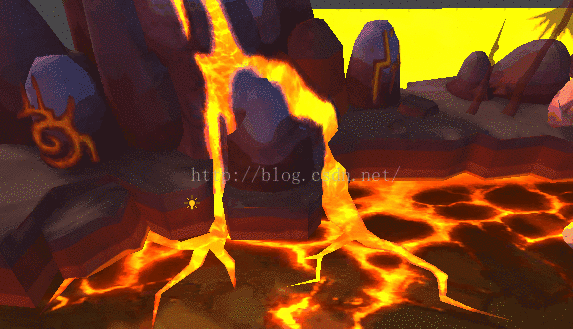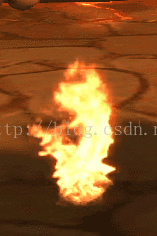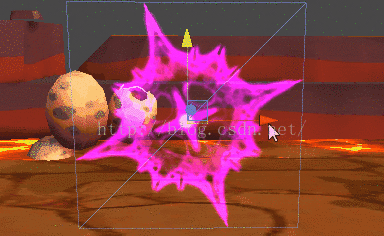UV动画
UV动画,顾名思义,就是针对UV做的动画。在游戏中,一些动态水面,飞流直下的瀑布,流动的岩浆,跳动的火焰等等,很多都是通过操作UV做的动画。在unity中我可以实用挂载脚本或者直接针对UV key动画帧做动画操作,而在本文中将通过shader编写实现三个比较常见的UV动画方式:
1.UV位移动画
2.UV序列帧动画
3.UV旋转动画
先从UV位移动画开始
我们将做一个流动岩浆的效果,在开始前,我们需要介绍下Unity内置变量_Time
float4 _Time : Time (t/20, t, t*2, t*3)
这是个随时间变化的增量,从函数的定义我们可以知道这个变量的4个分量速率比 _Time=20*_Time.x=_Time.y=_Time.z/2=_Time.w/3.
为了方便控制位移动画的速率和方向我们定义一个变量
_ScrollingSpeed("Scrolling speed", Vector) = (0,0,0,0)
在顶点函数中
将uv坐标乘以
_Time
变量和_ScrollingSpeed,下面为关键代码
o.uvScroll = TRANSFORM_TEX((v.texcoord.xy+_Time.x*_ScrollingSpeed.xy), _Tex);// 这里只使用了xy上的两个分量对应uv
VF版本代码01:
Shader "PengLu/Self-Illumin/IlluminDiffuseScrollVF"
{
Properties
{
_Color ("Main Color", Color) = (1,1,1,1)
_MainTex ("Base (RGB)", 2D) = "white" {}
_Illum ("Illumin (A)", 2D) = "white" {}
_Tex("Scroll Tex (RGB)", 2D)= "white" {}
_ScrollingSpeed("Scrolling speed", Vector) = (0,0,0,0)
}
SubShader
{
Tags { "RenderType"="Opaque" }
LOD 200
pass
{
CGPROGRAM
#pragma vertex vert
#pragma fragment frag
#include "UnityCG.cginc"
sampler2D _MainTex,_Illum,_Tex;
float4 _MainTex_ST,_Illum_ST,_Tex_ST,_Color,_ScrollingSpeed;
struct appdata {
float4 vertex : POSITION;
float2 texcoord : TEXCOORD0;
float2 texcoord1 : TEXCOORD1;
};
struct v2f {
float4 pos : POSITION;
float2 uv_MainTex : TEXCOORD0;
float2 uv_Illum : TEXCOORD1;
float2 uvLM : TEXCOORD2;
float2 uvScroll : TEXCOORD3;
};
v2f vert (appdata v)
{
v2f o;
o.pos = mul(UNITY_MATRIX_MVP,v.vertex)*_Color;
o.uv_MainTex = TRANSFORM_TEX(v.texcoord, _MainTex);
o.uv_Illum = TRANSFORM_TEX(v.texcoord, _Illum);
o.uvScroll = TRANSFORM_TEX((v.texcoord.xy+_Time.x*_ScrollingSpeed.xy), _Tex);
o.uvLM = v.texcoord1.xy * unity_LightmapST.xy + unity_LightmapST.zw;
return o;
}
float4 frag (v2f i) : COLOR
{
float4 texCol = tex2D(_MainTex, i.uv_MainTex);
float4 IllumTex = tex2D(_Illum,i.uv_Illum);
float3 lm = DecodeLightmap (UNITY_SAMPLE_TEX2D(unity_Lightmap, i.uvLM.xy));
IllumTex.rgb+=tex2D(_Tex,i.uvScroll).rgb;
IllumTex*=IllumTex.a;
texCol+=IllumTex;
texCol.rgb*=lm;
return texCol;
}
ENDCG
}
}
FallBack "Diffuse"
}
VF版本代码01效果:

UV序列帧动画
序列帧动画是游戏比较常用的一种动画形式,在unity自带的粒子系统中就可以设置序列帧动画(下图),但是这个只能用于粒子系统的粒子效果,如果是自己做的模型就要使用序列帧动画就得自己写脚本或shader,下面我们将用shader实现序列帧动画效果。

首先得准备一张序列帧的贴图,如下图这样的:

然后我们需要声明三个变量:
_SizeX ("SizeX", Float) = 4//列数
_SizeY ("SizeY", Float) = 4//行数
_Speed ("Speed", Float) = 200//动画的播放速度
在frag函数里面处理动画
int indexX=fmod (_Time.x*_Speed,_SizeX);//获得列数的循环
int indexY=fmod ((_Time.x*_Speed)/_SizeX,_SizeY);//获得行数的循环fmod函数是取余函数,int用来强制取整,当然也可以用floor函数来取整
为了直观解释,将用下面的列表列出上面变量的值的对应关系,假设_SizeX=_SizeY=4
_Time.x*_Speed | 0 | 1 | 2 | 3 | 4 | 5 | 6 | 7 | 8 | 9 | 10 | 11 | 12 | 13 | 14 | 15 |
indexX | 0 | 1 | 2 | 3 | 0 | 1 | 2 | 3 | 0 | 1 | 2 | 3 | 0 | 1 | 2 | 3 |
indexY | 0 | 0 | 0 | 0 | 1 | 1 | 1 | 1 | 2 | 2 | 2 | 2 | 3 | 3 | 3 | 3 |
_Time.x*_Speed | 16 | 17 | 18 | 19 | 20 | 21 | 22 | 23 | 24 | 25 | 26 | 27 | 28 | 29 | 30 | 31 |
indexX | 0 | 1 | 2 | 3 | 0 | 1 | 2 | 3 | 0 | 1 | 2 | 3 | 0 | 1 | 2 | 3 |
indexY | 0 | 0 | 0 | 0 | 1 | 1 | 1 | 1 | 2 | 2 | 2 | 2 | 3 | 3 | 3 | 3 |
参考网络上的例子我还有写了另外一种获得循环动画的代码(我是孔乙己啦),和上面两句功能是一样的,貌似消耗稍微少一点
int index = floor(_Time .x * _Speed);
int indexY = index/_SizeX;
int indexX = index - indexY*_SizeX; 通过列表对应,可以看出获取循环数的差别
index | 0 | 1 | 2 | 3 | 4 | 5 | 6 | 7 | 8 | 9 | 10 | 11 | 12 | 13 | 14 | 15 |
indexX | 0 | 1 | 2 | 3 | 0 | 1 | 2 | 3 | 0 | 1 | 2 | 3 | 0 | 1 | 2 | 3 |
indexY | 0 | 0 | 0 | 0 | 1 | 1 | 1 | 1 | 2 | 2 | 2 | 2 | 3 | 3 | 3 | 3 |
index | 16 | 17 | 18 | 19 | 20 | 21 | 22 | 23 | 24 | 25 | 25 | 27 | 28 | 29 | 30 | 31 |
indexX | 0 | 1 | 2 | 3 | 0 | 1 | 2 | 3 | 0 | 1 | 2 | 3 | 0 | 1 | 2 | 3 |
indexY | 4 | 4 | 4 | 4 | 5 | 5 | 5 | 5 | 6 | 6 | 6 | 6 | 7 | 7 | 7 | 7 |
接下来将获得的循环数与uv贴图的UV进行操作
fixed2 seqUV = float2((i.texcoord.x) /_SizeX, (i.texcoord.y)/_SizeY);//将uv切分
seqUV.x += indexX/_SizeX;//U方向上循环
seqUV.y -= indexY/_SizeY;//V方向上循环
VF版本代码02:
Shader "PengLu/Particle/SequenceAdd" {
Properties {
_TintColor ("Tint Color", Color) = (0.5,0.5,0.5,0.5)
_MainTex ("Particle Texture", 2D) = "white" {}
_InvFade ("Soft Particles Factor", Range(0.01,3.0)) = 1.0
_SizeX ("SizeX", Float) = 4
_SizeY ("SizeY", Float) = 4
_Speed ("Speed", Float) = 200
}
Category {
Tags { "Queue"="Transparent" "IgnoreProjector"="True" "RenderType"="Transparent" }
Blend SrcAlpha One
AlphaTest Greater .01
ColorMask RGB
Cull Off Lighting Off ZWrite Off Fog { Color (0,0,0,0) }
SubShader {
Pass {
CGPROGRAM
#pragma vertex vert
#pragma fragment frag
#pragma multi_compile_particles
#include "UnityCG.cginc"
sampler2D _MainTex;
fixed4 _TintColor;
fixed _SizeX;
fixed _SizeY;
fixed _Speed;
struct appdata_t {
float4 vertex : POSITION;
fixed4 color : COLOR;
float2 texcoord : TEXCOORD0;
};
struct v2f {
float4 vertex : POSITION;
fixed4 color : COLOR;
float2 texcoord : TEXCOORD0;
#ifdef SOFTPARTICLES_ON
float4 projPos : TEXCOORD1;
#endif
};
float4 _MainTex_ST;
v2f vert (appdata_t v)
{
v2f o;
o.vertex = mul(UNITY_MATRIX_MVP, v.vertex);
#ifdef SOFTPARTICLES_ON
o.projPos = ComputeScreenPos (o.vertex);
COMPUTE_EYEDEPTH(o.projPos.z);
#endif
o.color = v.color;
o.texcoord = TRANSFORM_TEX(v.texcoord,_MainTex);
return o;
}
sampler2D _CameraDepthTexture;
float _InvFade;
fixed4 frag (v2f i) : COLOR
{
#ifdef SOFTPARTICLES_ON
float sceneZ = LinearEyeDepth (UNITY_SAMPLE_DEPTH(tex2Dproj(_CameraDepthTexture, UNITY_PROJ_COORD(i.projPos))));
float partZ = i.projPos.z;
float fade = saturate (_InvFade * (sceneZ-partZ));
i.color.a *= fade;
#endif
int indexX=fmod (_Time.x*_Speed,_SizeX);
int indexY=fmod ((_Time.x*_Speed)/_SizeX,_SizeY);
// 以下三行代码和之前两行代码功能一样
// int index = floor(_Time .x * _Speed);
// int indexY = index/_SizeX;
// int indexX = index-indexY*_SizeX;
fixed2 seqUV = float2((i.texcoord.x) /_SizeX, (i.texcoord.y)/_SizeY);
seqUV.x += indexX/_SizeX;
seqUV.y -= indexY/_SizeY;
return 2.0f * i.color * _TintColor * tex2D(_MainTex, seqUV);
}
ENDCG
}
}
}
}
VF版本代码02效果:

UV旋转动画
UV旋转动画在游戏开发中用得相对比较少,特效师一般会采用其他方式代替,这里将用shader实现一个UV旋转的动画。 UV旋转实际上一个2D旋转,有关2D旋转的理论在 这里 。这边文章里讲得比较透彻,在这里我只需要拿到最终结果公式:
x' = r*cosα*cosθ - r*sinα*sinθ = x * cos θ – y * sin θ
y' = r*sinα*cosθ +r*cosα*sinθ = y * cos θ + x * sin θ
那么开始,同意需要声明一个变量来控制旋转方向和速度;
_Speed ("Speed", Float) = 200
接下来就要在frag函数里面操作UV,关键代码如下:
//将uv偏移0.5,使旋转中心到贴图中心
float2 uv=i.texcoord-0.5;
//定义一个二元变量,存储时间变量的正弦和余弦值
float2 rotate = float2(cos(_Speed*_Time.x),sin(_Speed*_Time.x));
//获得旋转后的uv坐标值
uv=float2((uv.x*rotate.x-uv.y*rotate.y),(uv.x*rotate.y+uv.y*rotate.x));
//将偏移的uv偏移回来
uv+=0.5; VF版本代码03
Shader "PengLu/Particle/RotationAdd" {
Properties {
_TintColor ("Tint Color", Color) = (0.5,0.5,0.5,0.5)
_MainTex ("Particle Texture", 2D) = "white" {}
_InvFade ("Soft Particles Factor", Range(0.01,3.0)) = 1.0
_Speed ("Speed", Float) = 200
}
Category {
Tags { "Queue"="Transparent" "IgnoreProjector"="True" "RenderType"="Transparent" }
Blend SrcAlpha One
AlphaTest Greater .01
ColorMask RGB
Cull Off Lighting Off ZWrite Off Fog { Color (0,0,0,0) }
SubShader {
Pass {
CGPROGRAM
#pragma vertex vert
#pragma fragment frag
#pragma multi_compile_particles
#include "UnityCG.cginc"
sampler2D _MainTex;
fixed4 _TintColor;
fixed _Speed;
struct appdata_t {
float4 vertex : POSITION;
fixed4 color : COLOR;
float2 texcoord : TEXCOORD0;
};
struct v2f {
float4 vertex : POSITION;
fixed4 color : COLOR;
float2 texcoord : TEXCOORD0;
#ifdef SOFTPARTICLES_ON
float4 projPos : TEXCOORD1;
#endif
};
float4 _MainTex_ST;
v2f vert (appdata_t v)
{
v2f o;
o.vertex = mul(UNITY_MATRIX_MVP, v.vertex);
#ifdef SOFTPARTICLES_ON
o.projPos = ComputeScreenPos (o.vertex);
COMPUTE_EYEDEPTH(o.projPos.z);
#endif
o.color = v.color;
o.texcoord = TRANSFORM_TEX(v.texcoord,_MainTex);
return o;
}
sampler2D _CameraDepthTexture;
float _InvFade;
fixed4 frag (v2f i) : COLOR
{
#ifdef SOFTPARTICLES_ON
float sceneZ = LinearEyeDepth (UNITY_SAMPLE_DEPTH(tex2Dproj(_CameraDepthTexture, UNITY_PROJ_COORD(i.projPos))));
float partZ = i.projPos.z;
float fade = saturate (_InvFade * (sceneZ-partZ));
i.color.a *= fade;
#endif
float2 uv=i.texcoord-0.5;
float2 rotate = float2(cos(_Speed*_Time.x),sin(_Speed*_Time.x));
uv=float2((uv.x*rotate.x-uv.y*rotate.y),(uv.x*rotate.y+uv.y*rotate.x));
uv+=0.5;
return 2.0f * i.color * _TintColor * tex2D(_MainTex, uv);
}
ENDCG
}
}
}
}
VF版本代码03效果:

PS:贴图的Wrap Mode要设置成Clamp,原因你懂的 ^_^



















